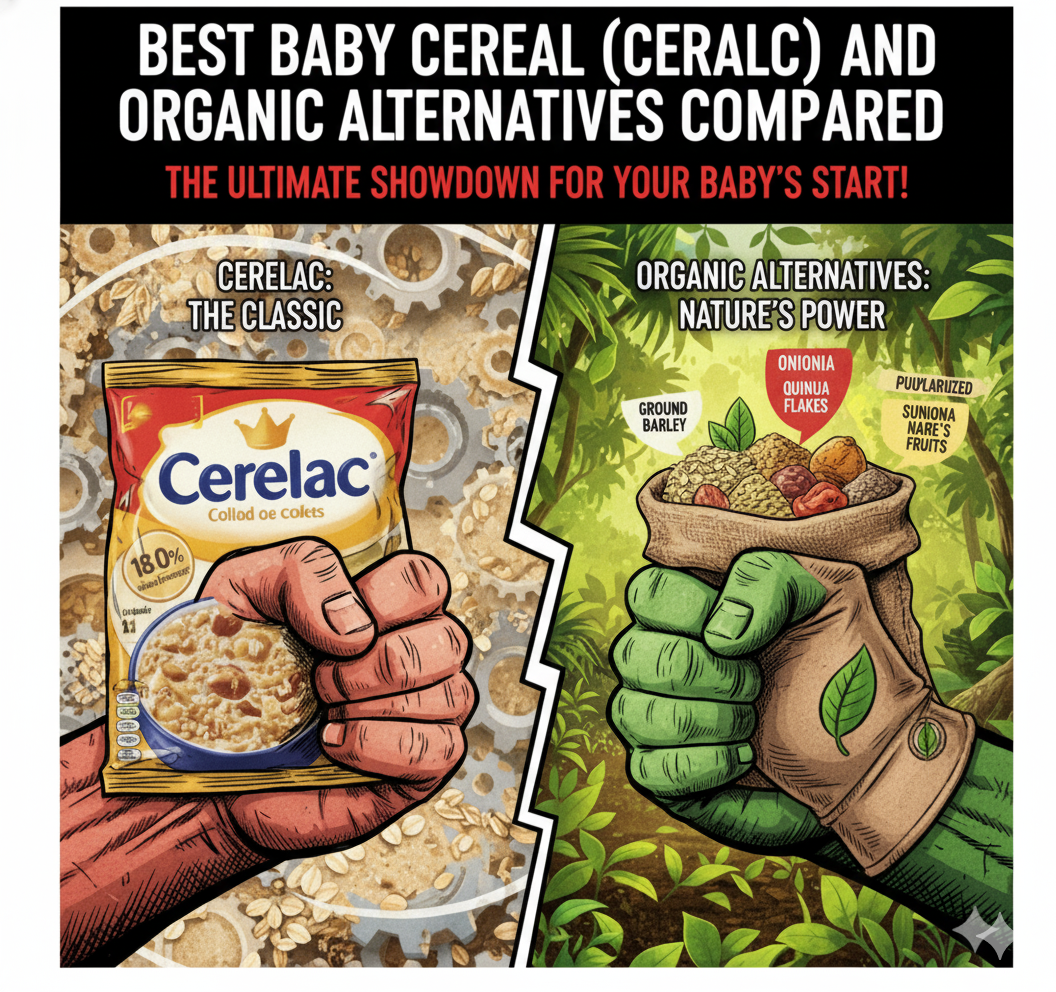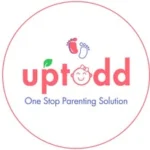
Brain Development Food for Babies at the age of 1 year
Topic
Brain Development Food for Babies at the age of 1 year
May start as early as
At 1 year
─────────
May end around
Always required
Related Skills
Baby diets, Bonding, Memory, Gross Motor Skills, standing, walking
Top Brain Development Food for 1 Year Old Babies
At 1 year old, your baby’s brain is rapidly developing. Nutrients like DHA, iron, zinc, and choline play key roles in supporting memory, learning, and focus. Include foods like eggs, fish, avocado, and dairy in your child’s daily meals to boost brain health. During this time, babies need a significant amount of nutrition to not only support physical development, but also to maintain the energy levels required for the day. The energy is most utilized to fuel the rapid brain development and support the formation of millions of neural connections, and the process of myelination is required for smoother communication between brain cells and neurons.
Feeding babies with either breast milk or formula is encouraged for general wellness and nutrition, but it is no longer the major source of food. At this time, breast or formula feeding should be practiced 2/3 times a day. At the same time, the rest of the day should be focused on eating a nourishing mix of solid foods rich in proteins, calcium, iron, and good fats.
In this blog, we will discuss-
- Major Brain Development Areas at the age of 1 Year
- Key Nutrients for Development in Babies
- Foods to introduce at the age of 1 year
- Sample Diet Plan for babies at the age of 1 year
- Feeding safety and precautions to keep in mind
First of all, let’s begin with
Major Brain Development Areas at the age of 1 Year
At the age of 12 months, various structural and functional changes take place in your baby’s brain.
Major changes happen in certain areas of the brain:
Cerebral cortex
At the age of 1 year, the cerebral cortex that supports voluntary movements and thinking is thickening, and there is an increased folding of the surface. The degree of these cortical folds is related to brain size and cognitive complexity. The major nutrient needed is DHA, which forms the major structural component of the cerebral cortex.
Prefrontal cortex
This part of the brain is under rapid synaptic growth and is developing the most. The prefrontal cortex is responsible for higher cognitive functions such as attention, problem-solving, and emotional regulation.

Nutrients like antioxidants, vitamin B, and omega-3 fatty acids from a variety of food sources, such as chia seeds, avocado, etc., can support the brain’s prefrontal cortex.
Limbic system
Most of the changes happen in two major parts of the limbic system: the amygdala (responsible for emotional responses and attachment formation) and the hippocampus (responsible for memory formation). The brain needs a good amount of folate and iron for optimal development here.
Myelination
At 12 months, the frontal white matter is undergoing myelination and is complete by 14 months; this process supports faster neural communication. The brain requires DHA and other fatty acids to enhance the process of myelination.
References: Major Brain Development Areas at the age of 1 year
Now, let’s talk about what those power nutrients are for your 1-year-old.
Key Nutrients in brain development food for 1 year old
By the end of the first year, the baby’s food intake should be adequate and proportioned in order to keep up with the growth rate. The following nutrients are critical:
- Protein – Protein is necessary for the development of muscles and other tissues. The best sources for protein are seafood and meat.
- Iron – Iron is a basic component of hemoglobin and myoglobin and is hence an essential nutrient. It also helps in the growth of the brain and cognitive functions.
- Calcium – For the process of bone mineralization and calcification. Babies under 1 year can get calcium from breast milk, formula, and later, from foods like yogurt and cheeses.
- Vitamins – Vitamins A, C, and E are essential to immune health, as well as the skin.
- Vitamin B – Vitamin B12 can help strengthen the memory area of our brain.
- Omega-3 – This fat helps foster neural connections and communication between brain cells. The best sources are fatty fish, such as tuna.
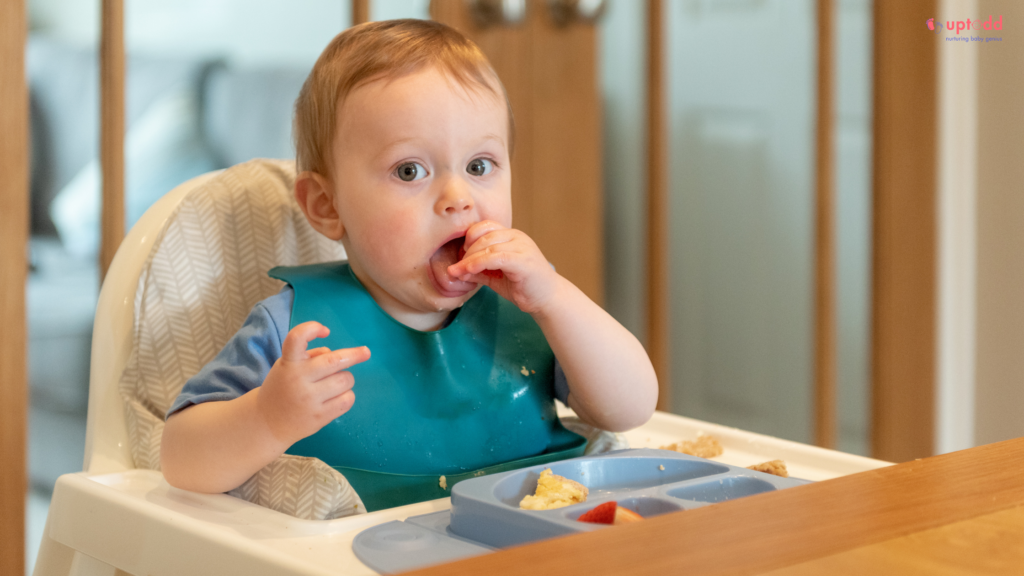
Now, the big question is…. what should be introduced in brain development food for 1 year old ?
Why brain development food for 1 year old matters?
At the age of 12 months, the baby’s digestive system develops to some extent, making it easier for the baby to eat a wider range of foods than was possible before. As long as the food is well prepared, i.e., well-cooked, soft, easy to chew, and cut into small pieces, you can offer a wide range of fruits, vegetables, dairy products, etc.
New foods that can be added:
Some foods that can be added around this stage, which were skipped earlier:
Full-Fat Milk
Whole cow milk can be offered to infants without any breast milk or formula supplementation; however, some mothers may still wish to breastfeed during this transition. Full-fat milk is a good source of calcium and fats; all these nutrients are crucial for brain cell growth and the myelination of nerves, which supports faster communication between neural connections.
Honey
Honey is suitable for use once your baby is a year old, and can be used as a sweetener in foods or in cooking.
Nuts and Seeds
Serve powdered nuts, nut butter, or chia and flax seeds for nutritional diversity, thereby preventing any choking risks. These are rich in omega-3 fatty acids, which are vital for cognitive development, memory, and emotional regulation.
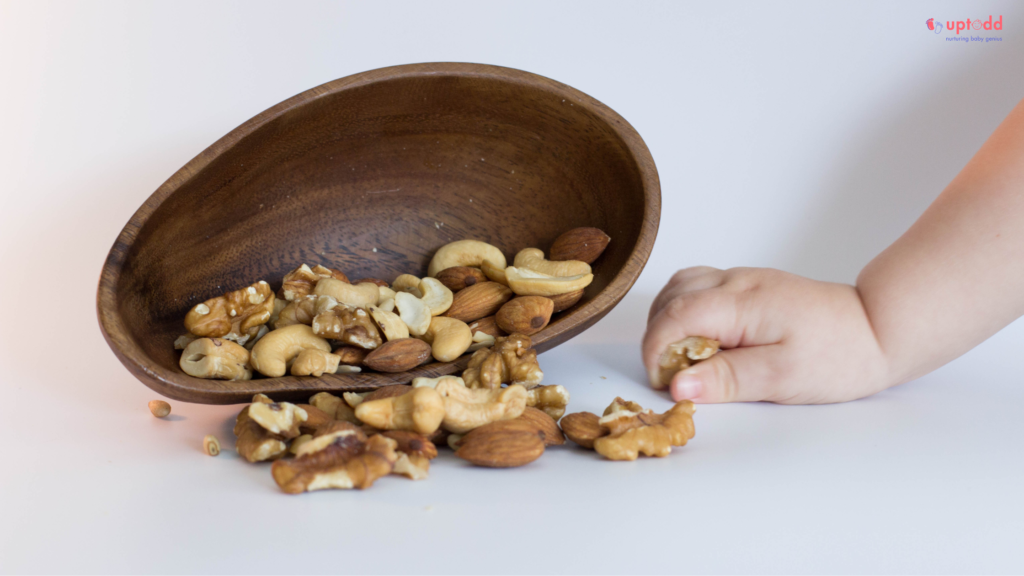
Foodstuffs with High Acidic Content
Excessive amounts of tomatoes or citrus foods. This can result in a diaper rash or irritation of the stomach before 1 year of age.
Chocolate or Cocoa
These contain caffeine and sugar, which are harmful to babies below one year of age. Introduced these only in minute quantities, only if utmost necessary (Avoid as much as possible).
Must to be introduced Brain development food for 1 year old
From the age of 1 year, it’s time to offer at least three main meals and two snacks. Since the brain uses more than half of the babies’ energy intake, a proper meal ensures that the supply of glucose is enough for the proper functioning of the brain. When offered irregular means to our baby, this may lead to dips in energy, affect learning, alertness, and overall development.
Food required in a good amount for babies aged 1:
Fruits and Vegetables
At this stage of an infant’s development, parents are encouraged to have about half of the babies’ food in the form of fruits and vegetables. This period is ideal for soft-cooked vegetables, boiled or mashed like carrots and sweet potatoes, and even ripe fruits such as bananas and avocados. They are also rich in essential vitamins and antioxidant content, which comes in handy in ensuring the good health of the child. Vitamin C found in vegetables and fruits helps your baby use the iron from their food for better brain development.
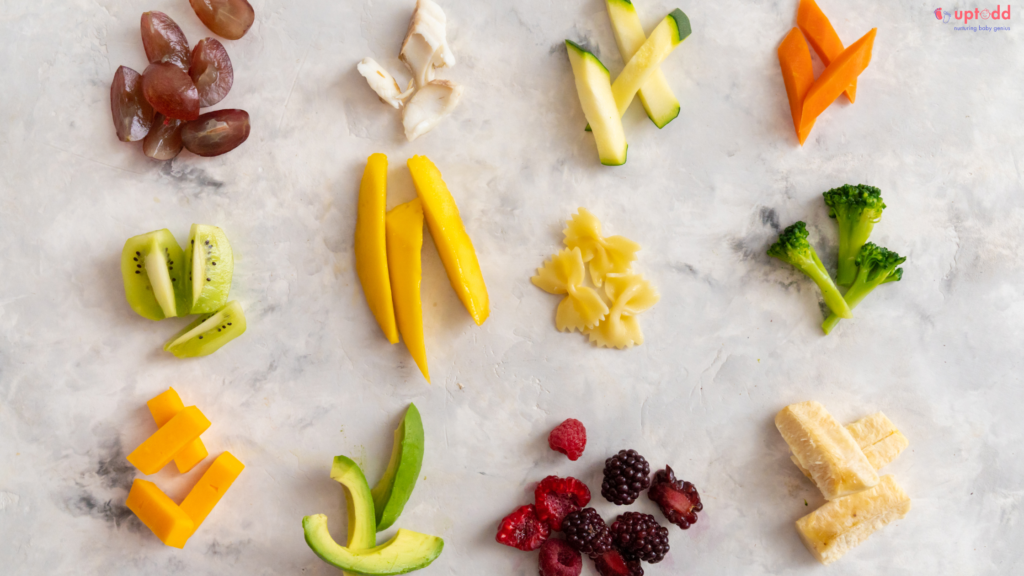
Grains and Cereals
These are usually provided especially to active toddlers because of their high energy-nourishing ability, and are rich in carbohydrates. You can add oatmeal, brown rice, or whole grain bread. When it’s nice and warm out, whole grains can be helpful in filling them up during long, playful activities because they are very high in fiber and assist in the digestive process.
Dairy
As the digestive system has developed to some extent by the age of 1 year, you can start introducing some dairy products such as Full-Fat Milk.
Whole grain
Whole grain foods are well known to provide steady energy throughout the day, which your baby requires for proper brain development. The whole grain foods may include oats, brown rice, and whole wheat bread.
Proteins
It is necessary to add different sources of protein into the diet. You can start with soft scrambled eggs, chicken cut into small pieces, or mashed beans. Protein-rich foods are needed not only for the baby’s growth and development but also to fill the baby up and keep him or her content.
References: Foods to Introduce at the age of 1 year
Now let’s explore the Sample Diet Plan for babies at the age of 1 year
Sample Diet Plan for babies at the age of 1 year
Okay, so you must be wondering, yes, I understand what and why nutritious food is important for my 1-year-old. But it would be better if I had an idea of what the meal plan for my baby should look like.
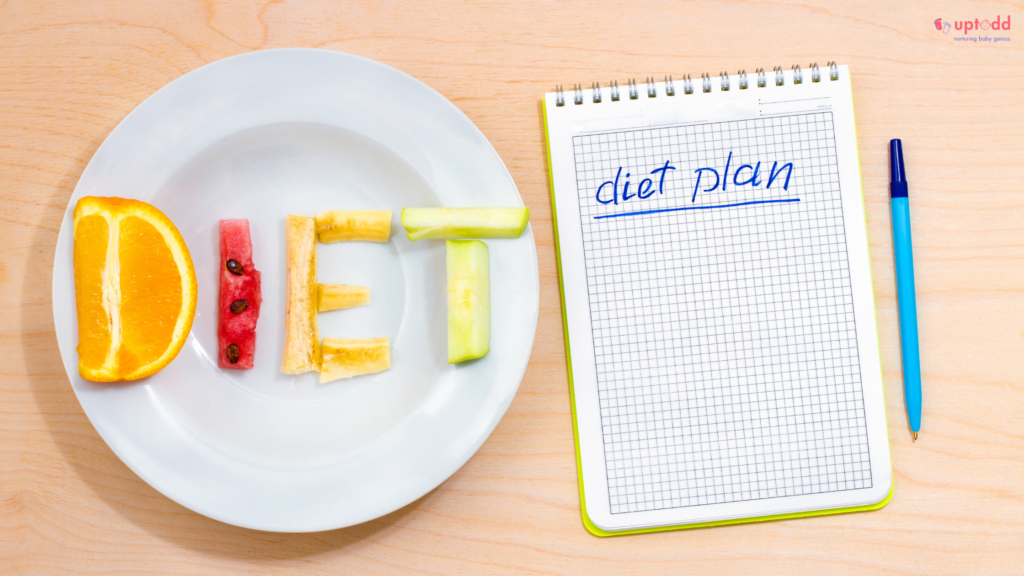
To make it simple enough for you to give a kind of idea of what it may look like, we have provided a sample diet plan below.
| Meal | Time | Food Option |
| Breastfeed | 7:30 am | Breastmilk/Formula feed session |
| Breakfast | 9 am | -Oats porridge with mashed banana– Vegetable paratha with curd |
| Morning Snack | 11:30 am | – Yogurt with fruit puree– Small pieces of boiled egg |
| Lunch | 1:30 pm | – Dal khichdi with ghee– Soft steamed fish with mashed rice and boiled spinach |
| Afternoon Snack | 4:30pm | – Whole grain crackers with avocado– Small cubes of steamed sweet potato |
| Dinner | 7:30 pm | – Mashed lentils with roti pieces– Plain pasta with a vegetable puree (carrot or pumpkin) |
| Breastfeed | 10 pm | Breastmilk/Formula feed session |
Tips:
- Change the serving sizes and increase according to your little one’s hunger levels.
- Over the course of a week, make sure to include different foods for nutrition’s sake.
- Give water in small quantities to help with digestion.
Feeding safety and Precautions to keep in mind
- Cut food into tiny pieces in order to minimise the risk of choking, as your baby is still learning to eat or self-feed.
- Check the food’s temperature before serving the meal. Try to offer lukewarm food to babies for their comfort and safety.
- Provide foods from different sources for a well-balanced diet, such as grains, proteins, fruits, etc., required for brain development and supporting the immunity of your baby.
- Do not give any fast foods, such as chips, cookies, or any other processed snacks. These foods are low in nutrients and can interfere with nutrient intake through good food, as the baby may feel full, but will not get nutrients.
- During meal time, try to stay with your baby to ensure safety. Supervision not only ensures safety but also improves the bond and social-emotional development.
- Do not provide any screen time during mealtime, as it may interfere with different developmental aspects.
- Breastfeed or give formula 2 times within a day.
Read More about 1 year old baby food & diet plan –
Read more for Weight gain guide for 1 year baby
Learn more about complete food plan of 1 year baby
Understand weight gain foods for 6-12 months baby
Conclusion
The first birthday is an important milestone for your baby, full of changes and growth, and so are their nutritional requirements. With the rapid brain growth taking place in different parts of the brain, mostly in the limbic, prefrontal, and cerebral cortex, the food you are offering plays an essential role in shaping cognitive skills, emotional well-being, and overall brain structure and functioning. We can help our baby’s healthy growth and development by providing a balanced variety of nutritious foods and following proper feeding guidelines. Keep in mind to speak to your paediatrician and have fun with this wonderful, growing, and learning stage about food.
Also, don’t forget to make the meal time stress-free, screen-free, fun, and full of exploration for the best brain development.
Explore Brain Development Food by Age
Looking for brain-boosting food recommendations for your baby at different growth stages? Explore our expert-backed age-specific guides:
Infants & Early Babies
- Brain Food for 6 Month Old Babies
Start your baby’s brain growth journey with safe, soft foods rich in iron, DHA, and fat. - Brain Development Food for 9 Month Old Babies
Learn which mashed solids and finger foods boost memory and focus before age 1. - Brain Development Food for 1 Year Old Babies
At 12 months, your baby needs more variety and healthy fats to fuel early learning.
Toddlers & Preschoolers
- Brain Development Food for 3 Year Olds
Support growing vocabulary and emotional development with the right toddler nutrition. - Brain Development Food for 4 Year Olds
Discover which foods improve focus, memory, and cognitive sharpness before school age.
👉 Read about food chart guide for 0-3 years
All Ages
- Brain Development Food for Babies (Complete Guide)
A comprehensive guide covering all the best brain foods from 6 months to 4 years old.
FAQs: Brain Food for 1 Year Olds
1. What is the best brain food for a 1 year old baby?
Egg yolks, fish (like mashed salmon), full-fat dairy, and avocados are great. They supply DHA, choline, iron, and fats crucial for brain growth.
2. How to improve brain development in a 1 year old?
Feed them nutrient-dense foods, engage in interactive play, read daily, and ensure good sleep routines.
3. Can I give nuts to my 1 year old for brain health?
Yes, in the form of nut butters (like peanut or almond), if there’s no allergy history. Avoid whole nuts.
4. How much milk should a 1 year old drink for brain support?
About 2–3 servings of full-fat milk or dairy products per day is ideal post-12 months.
5. Is banana good for baby brain development?
Yes, bananas offer natural glucose and vitamin B6, which help support memory and emotional regulation.
Explore UpTodd to unleash the hidden abilities of the baby.
Research & Resources
- https://kidshealth.org/en/parents/feed12yr.html
- https://www.rch.org.au/uploadedFiles/Main/Content/nutrition/guide-to-foods-babys-first-year.pdf
- https://www.unicef.org/parenting/food-nutrition/feeding-your-baby-1-2-years#:~:text=Each%20meal%20needs%20to%20be,they%20don’t%20have%20teeth
- https://www.adam-mila.com/brain-development-children-0-6-years/

